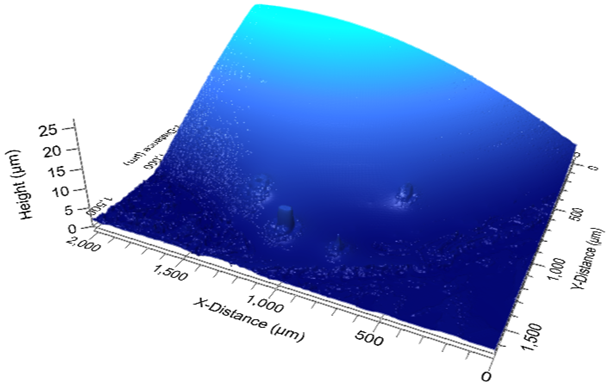Soft surfaces such as polymers, viscoelastic materials, and liquid metals present unique challenges in characterization and measurement. The KLA Instruments™ metrology portfolio includes optical profilers for non-contact surface topography and nanoindentation systems for mapping the mechanical properties of these materials.

Image Credit: KLA Instruments™
Surface roughness, waviness, defects, and profile features of soft materials such as silicones, gels, lightly cross-linked elastomers, and soft metals can present a metrology challenge due to their low resistance to deformation. Optical profilometry is a non-contact measurement technique that works well for generating detailed 3D topography of these and other soft surfaces.
As soft materials often have time- or frequency-dependent material responses, understanding the necessary measurement parameters to accurately measure a surface is quite challenging. For example, Silly Putty - a common toy model for rubbery systems - flows and behaves plastically when deformed at low rates of deformation (strain rate) but will behave elastically like a rubber ball when thrown to the floor due to the high strain rate at impact. Similar mechanical responses are present in other soft materials, including silicones, gels, and other polymer systems.
KLA Instruments has developed its metrology portfolio specifically to address many of the measured challenges posed by soft materials. With KLA Instruments’ tools, you can understand your material behavior more than just under artificial static conditions. Many research groups are now making use of this instrumentation for advanced fundamental studies of how microparticles move and how static friction works for soft materials1 or monitoring battery operation and performance.2

Figure 1. Non-contact surface measurement of a receding water droplet from the Filmetrics® Profilm3D®. Image Credit: KLA Instruments™
Microscale, Soft Friction
There are still many gaps in our understanding of how friction works for very soft objects on the microscale. Along with the complexities of having time- or frequency-dependent responses as many viscoelastic materials do, the very softest materials almost look like liquids with capillary-like action as they undergo deformation.
Recent work from Professor Jonathan Pham's team at the University of Cincinnati has unveiled how microparticles begin to move on soft, adhesive surfaces and the details of the small folds and stresses the surface undergoes during this motion. Their results are an important development in understanding the forces involved in the friction and slip of such interfacial interactions and how to develop the optimum surfaces for controlling such motions.
The team made use of a number of soft metrology techniques, including force metrology with specialized high-precision stages and confocal microscopy, as well as AFM cantilevers, to exert the forces on the samples. Image analysis was also important for looking at the polymer and substrate movement as well as simulation support to better understand the underlying physics.
Batteries
Another place where soft materials have a surprising role to play is in batteries. The movement of liquid metals in electrochemical cells is an essential part of how batteries function, particularly in rechargeable systems.3
Professor Michael Dickey and his collaborators at NCSU have been particularly interested in the soft matter physics governing how the droplets of metals move and interact with the cathode and anode and how this movement affects the shape of the drops that are transferred.
One of the team’s most significant findings was directly associated with changing the voltages across the cell. They discovered that this change in voltage can be used to selectively transfer and detach a specific droplet, and this process can be manipulated by changing the distance between the cathode and droplet.
Metrology tools and supporting simulations allowed the team to visualize some of the exotic shapes the liquid metal droplets would adopt during the transfer process, as well as pinpoint exactly how they would interact and separate with the cathode and anode surfaces.
Come join Dr. Pham, Dr. Dickey and KLA Instruments at the free Metrology for Soft Materials Virtual Symposium on September 14, 2023 to learn more about some of the latest developments in the field and metrology techniques for your soft materials measurements.
KLA Instruments
KLA Instruments is active in instrument design, development, and research, including non-contact optical microscopy and biomaterial nanoindentation. Nanoindentation is a powerful method for measuring the force and stress response of nanoscale materials, but it does not always work for softer materials.4 This is because it can be difficult to know the exact area of contact between the punch and tissue, and it is hard to measure the exact contact stiffness and damping when the material is very compliant. The KLA iNano® is designed for testing exactly these kinds of challenging systems, and now these methods can be used on a wider variety of material types.
KLA Instruments offers a wide range of metrology and defect inspection solutions for surface and materials analysis across many industries and applications. Learn more at kla-instruments.com.
References and Further Reading
- Glover, J. D., Yang, X., & Pham, J. T. (2023). Creasing in microscale , soft static friction. Nature Communications, 14, 2362. https://doi.org/10.1038/s41467-023-38091-7"https://doi.org/10.1038/s41467-023-38091-7
- Wang, X., He, Y., You, J., & Dickey, M. (2023). Non-contact Transfer of Liquid Metal from an Anode to Cathode without Short Circuiting. 1–13. Preprint
- Bhattacharyya, A. J., Patel, M., & Das, S. K. (2009). Soft matter lithium salt electrolytes: Ion conduction and application to rechargeable batteries. Monatshefte Fur Chemie, 140(9), 1001–1010. https://doi.org/10.1007/s00706-009-0132-8"https://doi.org/10.1007/s00706-009-0132-8
- Li, X., & Bhushan, B. (2002). A review of nanoindentation continuous stiffness measurement technique and its applications. Materials Characterization, 48(1), 11–36. https://doi.org/10.1016/S1044-5803(02)00192-4

This information has been sourced, reviewed and adapted from materials provided by KLA Instruments™.
For more information on this source, please visit KLA Instruments™ .